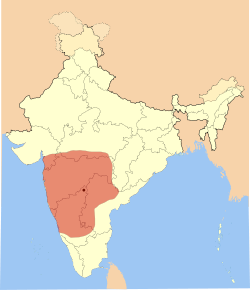Western Chalukya Empire
| Western Chalukya Empire | ||||||||||||||
| ಚಾಲುಕ್ಯ | ||||||||||||||
| Empire (Subordinate to Rashtrakuta until 973) |
||||||||||||||
|
||||||||||||||
|
Extent of Western Chalukya Empire, 1121 CE
|
||||||||||||||
| Capital | Manyakheta, Basavakalyan | |||||||||||||
| Languages | Kannada | |||||||||||||
| Religion | Hindu | |||||||||||||
| Government | Monarchy | |||||||||||||
| King | ||||||||||||||
| • | 957 – 997 | Tailapa II | ||||||||||||
| • | 1184 – 1189 | Someshvara IV | ||||||||||||
| History | ||||||||||||||
| • | Earliest records | 957 | ||||||||||||
| • | Established | 973 | ||||||||||||
| • | Disestablished | 1189 | ||||||||||||
|
||||||||||||||
|
||||||||||||||||||||||||||||||||
|---|---|---|---|---|---|---|---|---|---|---|---|---|---|---|---|---|---|---|---|---|---|---|---|---|---|---|---|---|---|---|---|---|
The Western Chalukya Empire ruled most of the western Deccan, South India, between the 10th and 12th centuries. This Kannadiga dynasty is sometimes called the Kalyani Chalukya after its regal capital at Kalyani, today's Basavakalyan in Karnataka and alternatively the Later Chalukya from its theoretical relationship to the 6th-century Chalukya dynasty of Badami. The dynasty is called Western Chalukyas to differentiate from the contemporaneous Eastern Chalukyas of Vengi, a separate dynasty. Prior to the rise of these Chalukyas, the Rashtrakuta empire of Manyakheta controlled most of Deccan and Central India for over two centuries. In 973, seeing confusion in the Rashtrakuta empire after a successful invasion of their capital by the ruler of the Paramara dynasty of Malwa, Tailapa II, a feudatory of the Rashtrakuta Dynasty ruling from Bijapur region defeated his overlords and made Manyakheta his capital. The dynasty quickly rose to power and grew into an empire under Someshvara I who moved the capital to Kalyani.
For over a century, the two empires of Southern India, the Western Chalukyas and the Chola dynasty of Tanjore fought many fierce wars to control the fertile region of Vengi. During these conflicts, the Eastern Chalukyas of Vengi, distant cousins of the Western Chalukyas but related to the Cholas by marriage took sides with the Cholas further complicating the situation. During the rule of Vikramaditya VI, in the late 11th and early 12th centuries, the Western Chalukyas convincingly contended with the Cholas and reached a peak ruling territories that spread over most of the Deccan, between the Narmada River in the north and Kaveri River in the south. His exploits were not limited to the south for even as a prince, during the rule of Someshvara I, he had led successful military campaigns as far east as modern Bihar and Bengal. During this period the other major ruling families of the Deccan, the Hoysalas, the Seuna Yadavas of Devagiri, the Kakatiya dynasty and the Southern Kalachuris of Kalyani, were subordinates of the Western Chalukyas and gained their independence only when the power of the Chalukya waned during the later half of the 12th century.
...
Wikipedia

